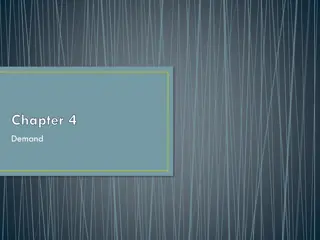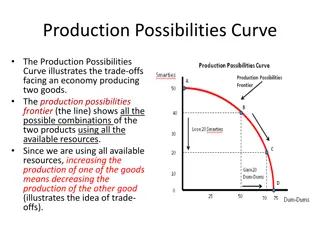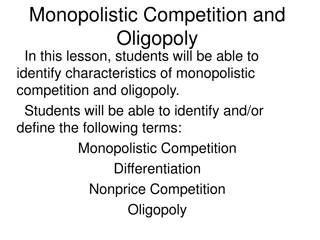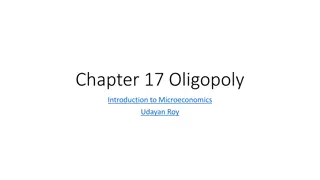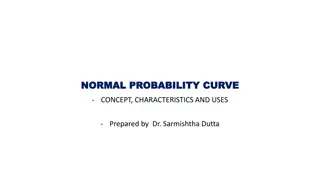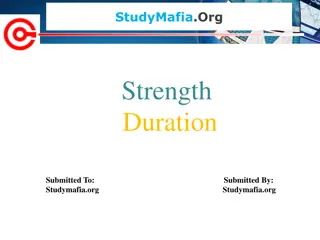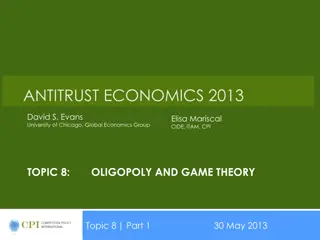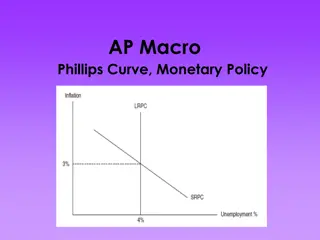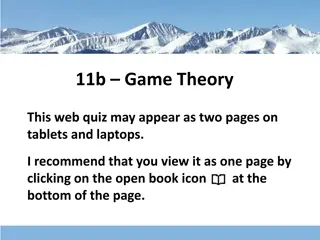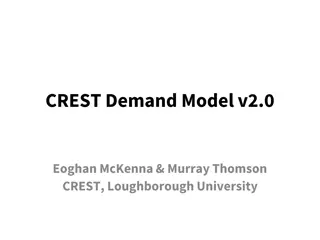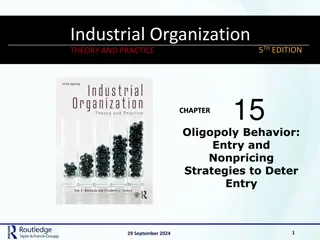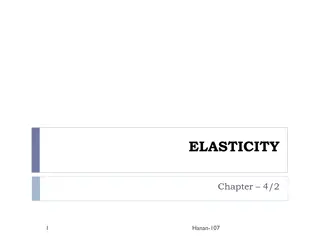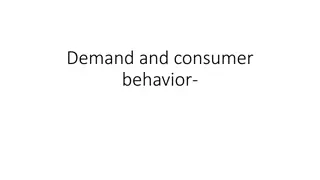Understanding the Kinked Demand Curve Model in Oligopoly
The kinked demand curve model in oligopoly, developed by Paul M. Sweezy, highlights stability in pricing and output decisions among firms. This model suggests that rival firms may react asymmetrically to price changes, leading to a kink at a certain price level. Assumptions include few firms producing close substitute products with no quality differentiation. The model shows how firms adjust prices based on rival reactions, aiming to maintain market share and profitability.
Download Presentation

Please find below an Image/Link to download the presentation.
The content on the website is provided AS IS for your information and personal use only. It may not be sold, licensed, or shared on other websites without obtaining consent from the author. Download presentation by click this link. If you encounter any issues during the download, it is possible that the publisher has removed the file from their server.
E N D
Presentation Transcript
Kinked Demand Curve Model Prepared by Anindita Chakravarty
INTRODUCTION The kinked demand curve of oligopoly was developed by Paul M. Sweezy in 1939. The model advocates that the behavior of oligopolistic organizations remain stable when the price and output are determined. This implies that an oligopolistic market is characterized by a certain degree of price rigidity or stability, especially when there is a change in prices in downward direction. There can be two possible reactions of rival organizations when there are changes in the price of a particular oligopolistic organization. The rival organizations would either follow price cuts, but not price hikes They may not follow changes in prices at all.
ASSUMPTIONS There are few firms in the oligopolistic industry. The product produced by one firm is a close substitute for the other firms. There is no differentiation in quality of the product. There are no advertising expenditures. There is an established or prevailing market price for the product at which all the sellers are satisfied. Each seller s attitude depends on the attitude of his rivals.
THE MODEL The relevant demand curve is Pd'. The two parts of the demand curve are DP and Pd', which is DPd' with a kink at point P. MC curve intersects MR at point Y where at output OQ. At point Y, the organization would achieve maximum profit.
The slope of a kinked demand curve differs in different conditions, such as price increase and price decrease. In this model, every organization faces two demand curves. In case of high prices, an oligopolistic organization faces highly elastic demand curve, which is dd' in Figure-2.On the other hand, in case of low prices, the oligopolistic organization faces inelastic demand curve, which is DD'. Suppose the prevailing price of a product is PQ. If one of the oligopolistic organizations makes changes in its prices, then there can be three reactions of rival organizations. Firstly, when the oligopolistic organization would increase its prices, its demand curve would shift to dd' from DD'. In such a case, consumers would switch to rivals, which would lead to fall in the sales of the oligopolistic organization. In addition, the dP portion of dd' would be more elastic, which lies above the prevailing price. On the other hand, if price falls, the rivals would also reduce their prices, thus, the sales of the oligopolistic organization would be less. In such a case, the demand curve faced by the oligopolistic organization is PD', which lies below the prevailing price. Secondly, rival organizations will not react with respect to changes in the price of the oligopolistic organization. In such a case, the oligopolistic organization would face DD' demand curve. Thirdly, the rival organizations may follow price cut, but not price hike. If the oligopolistic organization increases the price and rivals do not follow it, then consumers may switch to rivals. Thus, the rivals would gain control over the market. Thus, the oligopolistic organization would be forced from dP demand curve to DP demand curve, so that it can prevent losing its customers. This would result in producing the kinked demand curve. On the other hand, if the oligopolistic organization reduces the price, the rival organizations would also reduce prices for securing their customers. Here, the relevant demand curve is Pd'. The two parts of the demand curve are DP and Pd', which is DPd' with a kink at point P. Let us draw the MR curve of the oligopolistic organization. The MR curve would take the discontinuous shape, which is DXYC, where DX and YC correspond directly to DP and Pd' segments of the kinked demand curve. The equilibrium point is attained when MR = MC. In Figure-2, the MC curve intersects MR at point Y where at output OQ. At point Y, the organization would achieve maximum profit. Now, if cost increases, the MC curve would move upwards to MC. In such a case, the oligopolistic organization cannot increase the prices. This is because if the organization would increase the prices, the rival organizations would decrease their prices and gain the market share. Moreover, the profits would remain same between point X and Y. Thus, there is no motivation for increasing or decreasing prices. Therefore, price and output would remain stable.
CRITICISMS It is not likely that the gap in the marginal revenue curve will be wide enough for the marginal cost curve to pass through it. It may be shortened even under conditions to fall in demand or costs, thereby making price unstable. Critics point out that the kinked demand curve analysis holds during the short- run, when the knowledge about the reactions of rivals are low. But it is difficult to guess correctly the rivals reactions in the long-run. Thus, the theory is not applicable in the long-run. According to some economists, the kinked demand curve analysis applies to an oligopolistic industry in its initial stages or to that industry in which new and previously unknown rivals enter the market. Kinked demand curve model ignores non-price competition among organizations. Non-price competition can be in terms of product differentiation, advertising, and other tools used by organizations to promote their sales. The analysis also ignores the application of price leadership and cartels, which account for larger share of the oligopolistic market.




